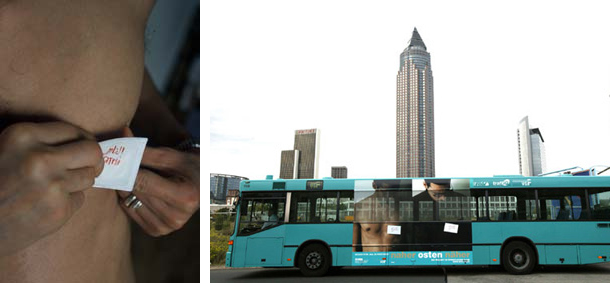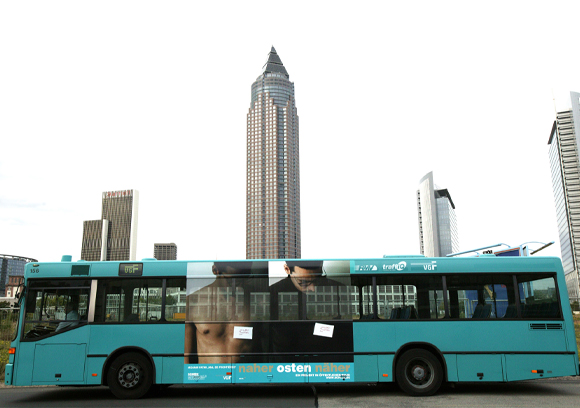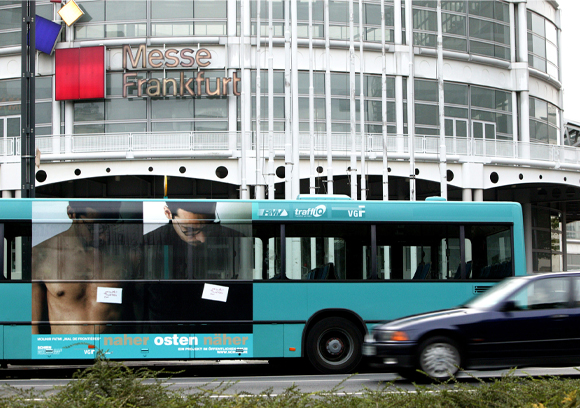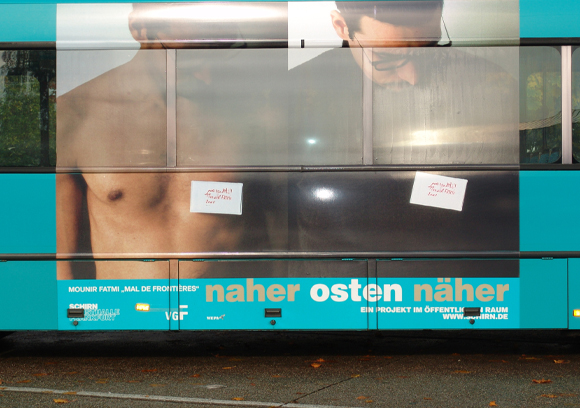| |
|
|
01.
| Border Sickness |
| |


2004, photographie, large poster on the bus.
Exhibition view from Nearer the near east, Schirn Kunsthalle frankfurt, 2004, Francfort.
Courtesy of the artist.
'' The work employs public transport vehicles of the city of Frankfurt as a support for the photographs: they are printed in large formats on transparent film and posted on the sides of buses crisscrossing the city. ''
Studio Fatmi, February 2017

Border Sickness
Exhibition view from Nearer the near east, Schirn Kunsthalle frankfurt, 2004, Francfort.
Courtesy of the artist.

Border Sickness
Exhibition view from Nearer the near east, Schirn Kunsthalle frankfurt, 2004, Francfort.
Courtesy of the artist.

Border Sickness
Exhibition view from Nearer the near east, Schirn Kunsthalle frankfurt, 2004, Francfort.
Courtesy of the artist.
|
|
|
|
|
|
Mal de frontières est à la fois une performance et une œuvre photographique. Performance, elle donne à voir l'artiste se saisissant d'un badge sur lequel sont inscrits ses nom et prénom et le fixant tour à tour à son vêtement et à sa poitrine nue, à même la peau. Œuvre photographique, elle consiste en un triptyque diptyque donnant à voir des portraits en buste de l'artiste, le représentant à la fois vêtu et torse nu, muni du badge dans les deux cas. L'œuvre utilise les véhicules de transport public de Francfort comme support pictural et les photographies de grand format sur film transparent sont finalement placardées sur les flancs des bus parcourant la ville.
Mounir Fatmi questionne son propre rapport à la question identitaire à partir de sa désignation en tant qu'artiste par les autres et par la société. Quels sont les rapports entre l'intime du sujet et ce qui relève du public ? Qu'est ce que l'identité dit d'une personne ? Peut-elle tout dire d'un individu ? Est-il possible pour ce dernier d'exister hors des stéréotypes sociaux et des attentes de la société ? Est-il possible enfin de s'affranchir de l'identité et des conditionnements sociaux qu'elle entraîne ?
Le recours au diptyque réalise la juxtaposition de formes canoniques : il permet, à partir d'une forme typique - le portrait en buste, d'en interroger une autre - l'identité. En posant côte à côte le sujet nu et le sujet habillé, il s'assimile à une forme de processus narratif donnant à voir les effets des marqueurs identitaires sur l'individu. Les portraits en buste manifestent une série de fidélités et d'écarts par rapport au topos pictural. Si le cadrage de la tête à la ceinture et la proximité avec le sujet représenté font partie des conventions graphiques liées à la forme, l'apparition inhabituelle des mains sur les photographies et le manque de visibilité du visage qui devrait apparaître bien dégagé constituent des transgressions notables. Le mains signalent peut-être une intervention personnelle de l'artiste dans la constitution de son identité. Et pourtant, le visage tourné vers le bas en direction du badge, Mounir Fatmi semble s'interroger sur ce qui devrait constituer le caractère le plus marquant de sa personnalité. Le visage incomplet, la transparence des images renvoient à une esthétique du doute, à l'opposé des évidences trompeuses délivrées par les marqueurs identitaires les plus courants. Le corps du sujet se voit traversé des images de la ville. Là où le portrait en buste est censé faire apparaître le personnage dans toute sa vérité, son utilisation par Mounir Fatmi en fait au contraire une figure du doute, et l'incertitude plane quant à l'identité réelle ou supposée du personnage.
Mal de Frontière manifeste une volonté et un désir de s'écarter des formes officielles, figées et sclérosantes. Il exprime également les rapports douloureux du sujet à sa propre identité. Le badge est cette étiquette sociale qui immobilise les individus en leur assignant un rôle, une fonction voire des traits de caractère forcément associés. Comme le portrait fait du sujet une nature morte, l'identité est une forme d'atteinte à l'intégrité des sujets, à l'image du système de marquage des individus établi par les régimes fascistes. Le choix du support vient au contraire exprimer un désir de mobilité. A la paralysie identitaire, Mounir Fatmi oppose le mouvement, le déplacement et les voyages qui permettent au sujet de maintenir les frontières entre lui et le monde ouvertes, de se laisser traverser par diverses influences, et finalement de se réinventer.
Studio fatmi, Février 2017. |
|
Border Sickness is both a performance and a photographic work. As a performance, it features the artist seizing a badge on which his name is written and sticking it successively on his clothes and on his bare chest. As a photographic work, it consists in a diptych of bust portraits of the artist, showing him both clothed and bare chested, wearing a badge in both cases. The work employs public transport vehicles of the city of Frankfurt as a support for the photographs: they are printed in large formats on transparent film and posted on the sides of buses crisscrossing the city.
Mounir Fatmi interrogates his own relation to the question of identity based on his designation as an artist by others and society. What is the relation between the intimacy of a subject and what belongs to the public sphere? What does identity say about a person? Can it say everything about an individual? Can that individual exist outside of social stereotypes and the expectations of society? And finally, is it possible to free oneself from identity and the social conditioning it entails?
Resorting to a diptych creates a juxtaposition of canonic forms: it allows the artist, using one typical form – the bust portrait – to question another: identity. By placing side by side the subject both naked and dressed, the work is akin to a form of narrative process showing the effects of identity markers on an individual. The bust portraits demonstrate both loyalty and distance from the pictorial topos. The framing from head to waist and the proximity with the subject belong to the graphic conventions that come with the form, but the unusual presence of hands on the photographs and the lack of visibility of the face that should be clearly visible represent significant transgressions. The hands might signal a personal intervention by the artist in the constitution of his identity. Yet, face down, looking at the badge, Mounir Fatmi seems to be wondering what should be the most significant characteristic of his personality. The incomplete face and the transparency of the images have to do with an esthetic of doubt, as opposed to the false certainties provided by common identity markers. The subject’s body is traversed by images of the city. The bust portrait is supposed to show a person with absolute truth, but its use by Mounir Fatmi turns it into a figure of doubt, and uncertainty remains as to the character’s real or supposed identity.
Border Sickness demonstrates a desire to distance oneself from official, fixed and fossilizing forms. It also expresses the painful relation of subjects to their own identity. The badge is the social labeling that immobilizes individuals by assigning them a role, a function and even their necessarily associated traits of character. As the portrait turns the subject into a still life, identity is a form of violation of the subjects’ integrity, like the marking system set up for individuals by fascist regimes. But here, the choice of the medium expresses a desire for mobility. To the paralysis of identity, Mounir Fatmi opposes movement and travel that allow subjects to keep open the border between themselves and the world, to let themselves be penetrated by diverse influences and ultimately to reinvent themselves.
Studio Fatmi, February 2017. |
|
|
|